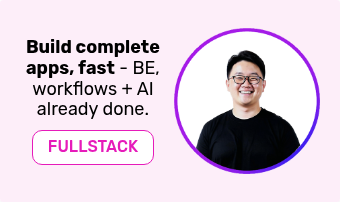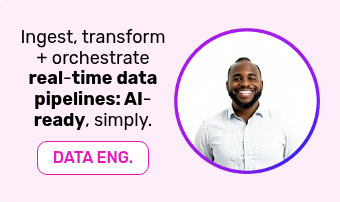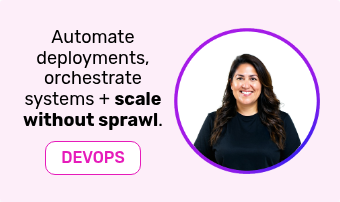Bubble Alternatives: Rayven.
The ultimate low-code app development platform battle.
Looking at Bubble alternatives or have you outgrown the platform? Still want AI-driven development capabilities? This is the comparison for you.

Rayven and Bubble are both low-code app development platforms, but serve different purposes and, to a certain extent, slightly different audiences.
Rayven is a full-stack, low-code platform aimed at a more technical audience that blends a combined an end-to-end app builder with universal integration, real-time data pipelines, workflow automation, and integrated AI tools.
Bubble, by contrast, is a pure no-code web app builder for designing responsive (think marketplaces, dashboards) with minimal coding.
Let’s dive into the detail.
Article by:
Paul Berkovic

Quick-Links: What's covered below?
To start, here’s a quick battlecard-style overview of how Rayven and Bubble stack-up on critical features:
| Capability | Rayven | Bubble |
|---|---|---|
| Dev model & UI | Full-stack low-code platform with AI prompt-to-build, drag‑and‑drop app builder and full code access. Inbuilt DataOps, LLMOps, Workflow Automation, iPaas, etc. - all-in-one model. | Fully visual no-code web app builder using drag‑drop layouts and rule-based workflows. |
| Extensibility / Plugins | Customisable beyond the UI – developers can inject HTML/JavaScript and add bespoke integration nodes (JS/SQL). | Large plugin ecosystem: thousands of pre-built plugins (UI widgets, API connectors, payments, etc.) and a plugin editor for custom JavaScript components. |
| Data integration | Integrates any data source: 200+ built-in connectors (cloud/REST/JSON APIs, databases, IoT protocols, etc.) plus file upload, online forms, QR code, and real-time data stream ingestion (multiple formats, including MQTT, AMQP, SQL, UDP, OPC etc.). Can code integrations to give universal interoperability. See more here. | Uses its own built-in database; external data via a generic API Connector (any REST/JSON API); dozens of community plugins extend connectivity. |
| Data schema | Hybrid SQL + Cassandra engine: tables can combine structured and time-series data in one place, with live schema evolution. | Relational-style data model: developer-defined “Data Types” with fields (supports up to ~1000 custom types). |
| Security & access | Enterprise-grade security: fine-grained role/permission controls, SAML/OAuth SSO support, data encryption and audit logging by design. | Standard SaaS security: TLS/SSL and backups by default; SAML SSO and team accounts available on Business/Enterprise plans (no published ISO/FedRAMP certifications). |
| Deployment & scale | Cloud-native and highly-scalable: microservices with Cassandra DB allow horizontal scaling (handles 1–100k+ users); supports multi‑cloud or on-prem deployment. | Bubble-managed AWS SaaS only: each app is an independent project scaled by allocating more compute/DB resources (measured by “workload” metric); suited to SMB/start-up scale. |
| Developer tools | Built-in visual IDE with prompt-to-build, drag‑and-drop workflow builder, plus support for custom scripting/injection (HTML/JS/SQL) for advanced development. | Browser-based visual IDE; includes a plugin editor for custom JavaScript logic and collaborative features (e.g. GitHub integration). |
In simple terms: Bubble excels at quickly spinning up standard apps (think marketplaces, dashboards) with minimal coding; whereas Rayven is for use cases where customisation, access to code, scaleability, integration, and data usage matters.
Features & Capabilities: a closer comparison of Rayven as a Bubble alternative.
-
Platform Model: Rayven is full-stack low-code (you can inject HTML/JS or call SQL/Cassandra, plus drag/drop widgets). Bubble is strictly no-code - you wire logic and UI visually with no server-side code (all custom logic is via plugins or client-side scripts).
-
Data & Integrations: Rayven offers 200+ native connectors (databases, SaaS, IoT, etc.) and lets developers write custom scripts for unique integrations - it's complete iPaaS. Bubble has a plugin ecosystem (thousands of pre-built modules for maps, payments, charts, etc.) and a generic API connector, but no raw back-end code access.
- Real-Time & Analytics: Rayven is built to handle streaming/time-series data and includes built-in machine learning and predictive analytics. Bubble’s runtime is request-driven on AWS – it does not natively process continuous data streams or embed ML; it handles standard web workflows only.

- Scalability: Rayven’s architecture separates services for “infinite” scaling (from 1 to 100,000+ users). It can run multi-region or on-premise for high performance. Bubble apps are hosted on Bubble’s managed AWS servers. Each app scales by upgrading its cloud instance (it can serve tens of thousands of users), but there is no built-in multi-app orchestration.
- Security & Compliance: Rayven emphasises enterprise security with features like role-based access, SSO/OAuth integration and data encryption. It even offers per-data-point permissions and audit logs for stringent control. Bubble, being a hosted SaaS, provides standard TLS encryption, backups and optional SAML SSO on higher tiers. However, Bubble does not publish ISO or FedRAMP certifications, so for strict compliance use-cases extra caution is needed.
- Deployment Options: Rayven supports both cloud (SaaS) and on-premise deployments, giving businesses full control over data residency. Bubble is cloud-only - every Bubble app runs on Bubble’s own servers (AWS).
- Pricing Models: Rayven’s pricing is usage-based: there’s a free tier for development, then fixed monthly tiers ($50/$500/$1000) with transaction limits. Bubble’s model is per-application: Free, Starter ($32), Growth ($134), Team ($399) and Enterprise (custom). Note Bubble’s paid plans apply per app, so multiple apps mean multiple bills.
- Ecosystem & Support: Rayven provides extensive built-in tooling (dashboards, form builders, ML toolkits) and technical documentation. Higher-tier plans include 24/7 phone/email support and on-site training. Bubble has a large community: Bubble University (video courses), an active forum, and thousands of third-party developers and agenciesrayven.io. It also has a massive template and plugin library, which Rayven lacks (Rayven offers connectors instead).
Rayven Pros:
- Designed for data-driven apps (streaming data, IoT, predictive analytics, universal interoperability).
- Combines UI building with a full data/automation stack (all-in-one).
- 200+ ready-made connectors (SaaS, databases, IoT protocols) for fast integration.
- Enterprise-grade security (encryption, roles, auditing) built-in.
- Scales horizontally (cloud-native) with on-premise option.
- Usage-based pricing (free tier, predictable tiers).
- 24/7 support and training for paid plans.
Rayven Cons:
- Smaller user community and fewer pre-built UI templates/plugins than Bubble.
- Learning curve for pure no-code users (it’s more technical; best leveraged by IT teams, developers, or users with some technical expertise).
- Rayven excels with data workflows and automation - for a simple static site or CRUD form, it may feel heavyweight.
- Premium features (machine learning, high usage limits) kick in at higher-tier pricing.
Bubble Pros:
- User-friendly UI builder (fully visual, drag/drop) – great for rapid prototyping of web apps.
- Massive plugin/template marketplace (charts, payments, maps, etc.) for quick features.
- Strong community and learning resources (forums, video tutorials).
- Hosting and scaling handled automatically (no ops needed).
- Cost-effective entry (free tier) and straightforward monthly plans.
Bubble Cons:
- Vendor lock-in: No way to export app code – you’re tied to Bubble’s environment.
- No on-prem hosting: All data lives on Bubble’s cloud – not suitable for strict data sovereignty requirements.
- No native mobile support: Bubble only builds web/PWA interfaces (mobile apps require wrappers with limited performance).
- Limited flexibility: Custom code is constrained to JavaScript plugins or HTML embeds – deep customisation is harder.
- Scaling limits: A single Bubble plan applies per app, so running multiple large apps gets costly.
- Standard SaaS security: Lacks enterprise certifications (ISO/FedRAMP), which may deter regulated industries.
Where Bubble falls short – and how Rayven fills the gaps.
Bubble is a great starting point. It's clean, visual, and ideal for building lightweight web apps fast. But when you need to go beyond simple front-ends - when you need real-time data, complex logic, scalable integrations and apps, or full control over where and how your app runs - you’ll hit the ceiling.
Here’s how Rayven closes the gaps:
1. Real-Time Data Processing & Streaming.Rayven can handle thousands of sensor readings per second with live dashboards and alerting. Bubble cannot.
- Rayven natively supports real-time ingestion, transformation, and analysis of high-frequency data (e.g., from IoT devices, machines, SCADA systems, financial APIs).
- Bubble lacks real-time data streaming or telemetry integration capabilities out-of-the-box.
2. Integrated AI & RAG Pipelines:
Rayven allows you to ground LLMs in operational/financial context - critical for enterprise AI.
- Rayven includes built-in support for embedding AI agents, LLMs, and Retrieval-Augmented Generation (RAG) frameworks directly into workflows.
- Bubble requires third-party plugins or external APIs to add LLM functionality and lacks native RAG pipeline integration.
3. Workflow-Driven Architecture:
Rayven’s workflows can trigger a UI update, launch an AI process, and write to multiple databases - all within milliseconds.
- Rayven features a visual workflow builder for data orchestration, ETL, alerts, decision automation, and UI updates—all in one.
- Bubble is focused on front-end design and UI flows with relatively shallow backend logic.
4. Dynamic & Modular UI Rendering:
Rayven is a more complete package, with customisability options that outweigh Bubble's.
- Rayven allows building data-driven UIs where widgets dynamically reflect streaming backend workflow outputs
- Bubble requires page refreshes or complex state management to simulate live interactivity.
5. Multiple Apps, One Platform:
Share logic. Reuse components. Control everything centrally.
- Bubble apps are siloed - pricing, configuration, and logic; making managing manage multiple apps or environments hard.
- Rayven is workspace-based, so you can build and manage multiple apps, users, and data pipelines in one place.
In short: Bubble is brilliant for building simple web apps fast - but it’s limited when it comes to real-time data, backend control, scale, and serious customisation. Rayven gives you everything Bubble can’t: real-time processing, full extensibility, enterprise-grade security, and the freedom to run your apps anywhere. It’s low-code without limits.
If you're building a simple web app, prototype, or internal tool with standard workflows and limited data complexity, Bubble is a strong starting point. Its visual builder and plugin ecosystem make it easy to get going quickly - especially if you're a non-developer or want to launch something lightweight, fast.
But when you're ready to scale - or if your app needs to handle real-time data, integrate with complex systems, or meet enterprise-level requirements - Rayven gives you what Bubble can't. It combines powerful low-code app development with the flexibility to build exactly what you need, deploy anywhere, and connect to everything. From advanced logic and AI to bullet-proof data pipelines and role-based access, Rayven is a true Bubble alternative that grows with you.
Ready to see it in action? You can try Rayven for free and explore everything it can do - no credit card, no friction - on our free forever plan. Or if you want to dive deeper, book a demo and we’ll walk you through it.
Rayven is a low-code platform built for data-intensive applications (real-time data, IoT, ML), offering drag-drop UI plus full backend access. Bubble is a no-code web app builder focused on UI/workflows only. Think of Rayven for complex data pipelines and enterprise apps, and Bubble for simpler web/SaaS prototypes.
Yes. Rayven is explicitly marketed as a low-code platform and a Bubble alternative. It offers all the visual app-building of Bubble plus advanced data and automation features. For developers needing streaming, control, DataOps, scaleability, LLMOps, or custom integrations; Rayven often outperforms Bubble.
Rayven is cloud-native and designed for high scalability. It promises “infinite” scale (from 1 to 100,000+ users) with multi-cloud or on-prem deployment. Bubble apps run on Bubble’s AWS infrastructure and can scale by moving to bigger instances, but Bubble is generally best for small-to-medium workloads, not huge enterprise portfolios.
Rayven uses a usage-based model: there’s a free tier, then $50, $500, $1000 per month levels with fixed data/transaction quotas. Bubble’s pricing is per app: Free, Starter ($32), Growth ($134), Team ($399) per month. Bubble charges for each app separately, whereas Rayven’s price covers workspace usage (multiple apps in one).
Rayven. It has built-in real-time data pipelines and IoT integrations. Bubble has no native real-time engine – it’s limited to handling web requests on its server. For time-series or sensor data applications, Rayven is specifically suited.
Rayven can be self-hosted (on-premise) or run in any cloud. Bubble cannot – all Bubble apps run on Bubble’s managed cloud infrastructure. If you need complete control over the hosting environment or offline scenarios, Rayven supports that; Bubble does not.
Bubble has a large user base and forum with thousands of active members, plus courses (Bubble University). Rayven’s community is smaller but more specialised. Rayven provides 24/7 technical support and training in higher plans, which many enterprises value. In short, Bubble has breadth (community resources), Rayven has depth (enterprise support).




















































